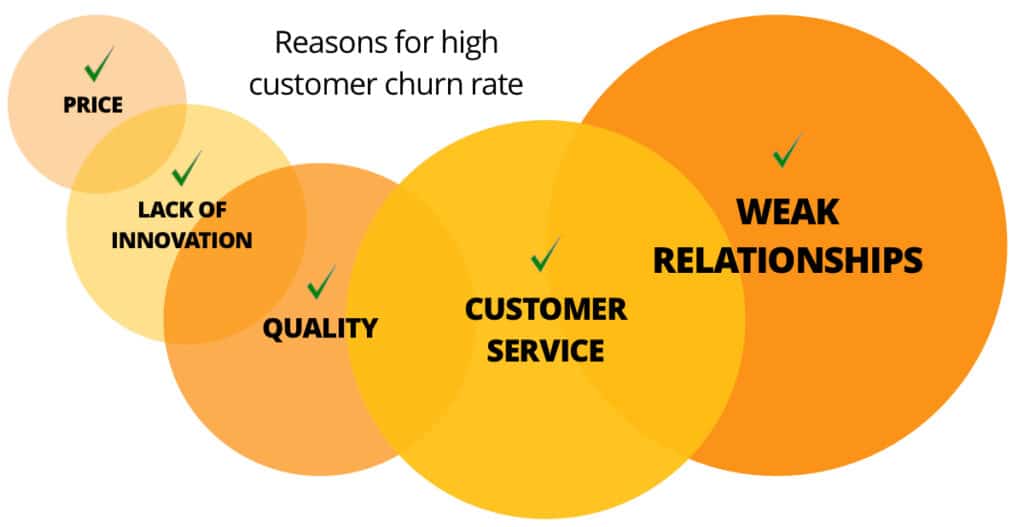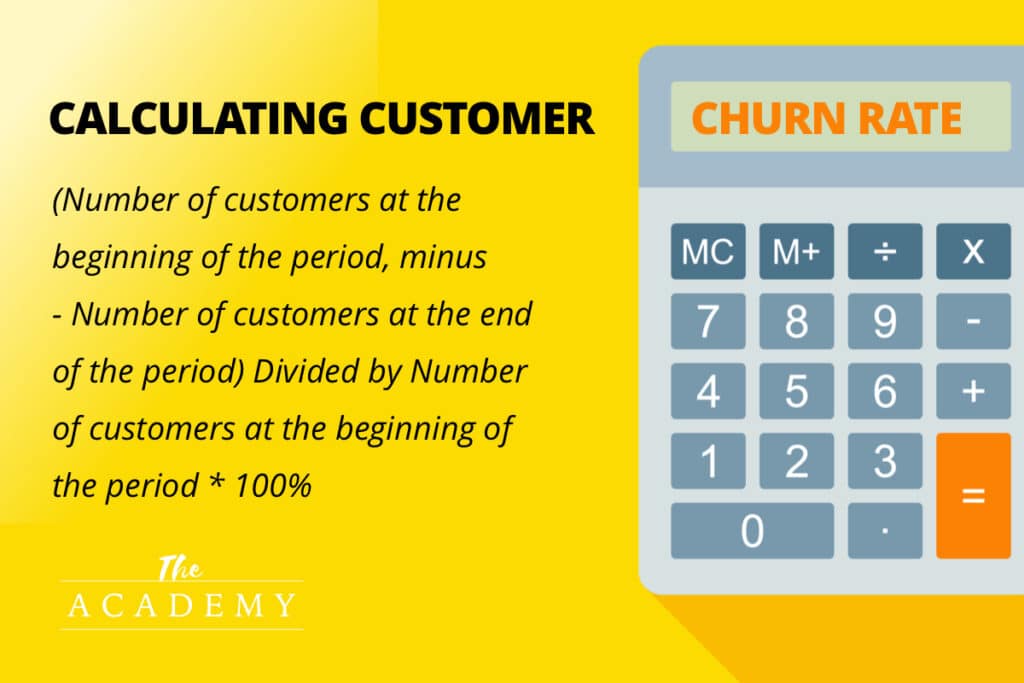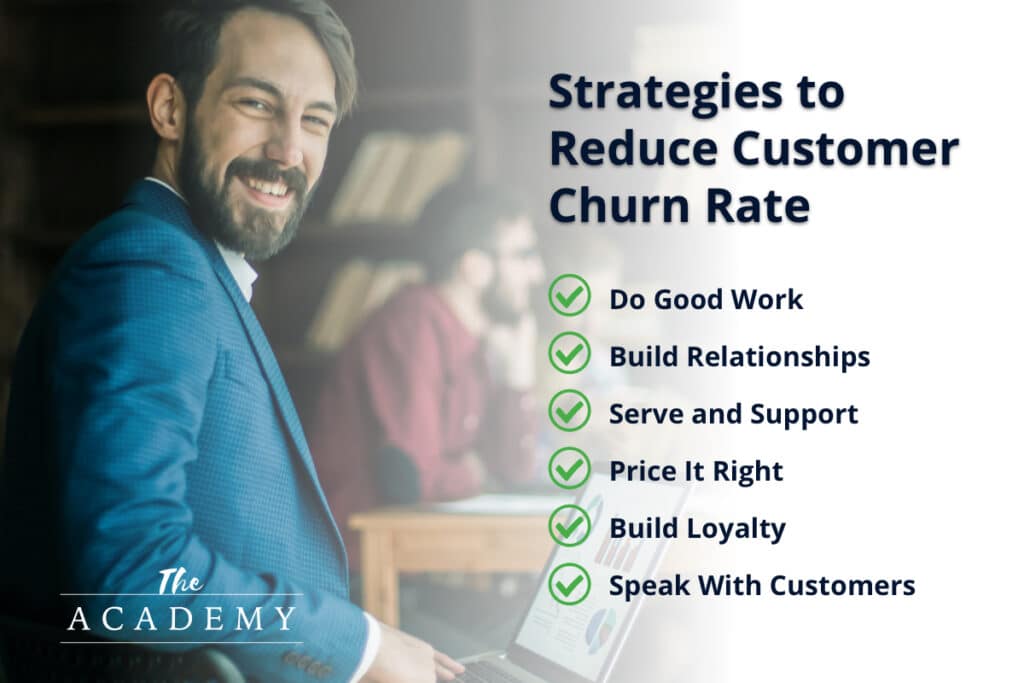
As a business owner or marketer, you’re always looking for ways to improve and grow your company, whether that’s through bringing in new business, increasing your profit margins, expanding your product offerings, or enhancing customer satisfaction.
One crucial metric often overlooked by businesses, particularly small and medium-sized enterprises, is the customer churn rate. Let’s discuss what a customer churn rate is, why it’s essential to track, how to calculate it, and strategies to reduce it.
What is Your Customer Churn Rate
Stat: It’s 5-25 times more expensive to acquire a new customer than to retain an existing one. Increasing customer retention by just 5% can boost profits by 25-95%.
Customer churn rate, also referred to as customer attrition rate, is a vital metric that measures the percentage of customers who discontinue using a particular product or service over a specified period. Essentially, these are your customers who no longer want to do business with you. Monitoring this rate is highly important as it can serve as an indicator of customer dissatisfaction, ultimately impacting the overall profitability of a business.
While this metric holds significance across various industries, particularly those with subscription-based models like telecommunications, software as a service (SaaS), and digital media platforms, it should not be overlooked by any business that values customer retention.
Understanding and calculating the customer churn rate provides valuable insights into the health of a company’s relationship with its customers. By analyzing how many customers are leaving within a given time frame, businesses can identify potential issues or areas for improvement in their products or services.
Factors Contributing to Customer Churn Rate
There are several key reasons why customers may choose to leave a product or service, contributing to the customer churn rate.

Poor quality
This is an obvious one. Poor product or service quality can result in a high churn rate as dissatisfied customers are more likely to stop using a product or service and switch to competitors with better offerings.
Lack of Innovation
An additional factor is the lack of innovation and failure to keep up with evolving customer needs and expectations. If a company fails to introduce new features, updates, or improvements that align with changing market trends, customers may become attracted to competitors who offer more innovative solutions.
Price
Price sensitivity can also play a crucial role in customer churn. Customers today have access to extensive information about pricing options and often seek out better deals elsewhere. If they perceive that they are not getting enough value for their money compared to what competitors are offering, they might be inclined to switch.
Poor Customer Service
Another substantial contributor is poor customer service experience. When customers encounter difficulties reaching support teams or receive unsatisfactory assistance when resolving issues or inquiries regarding product/service usage, it significantly impacts their overall satisfaction level. A negative interaction with customer service personnel can erode trust and loyalty toward a brand, leading customers straight into the arms of competitors who prioritize exceptional support services.
Weak Relationships
Having a solid relationship with your customers is critical. Without a strong relationship, personalization becomes challenging, leading to generic customer experiences that may not meet individual needs. Additionally, poor customer service often stems from a lack of understanding of the customer’s needs, which is a direct result of a weak relationship.
If there is no strong connection with a business, customers are less likely to remain loyal. They might switch to competitors who offer better experiences. Strong relationships foster trust, a lack of which can make customers question a company’s reliability and consider alternatives.
Engagement requires meaningful communication as well. Proactive advice, feedback, education, support, and regular updates about products or services are all foundational aspects of building strong relationships.
How to Calculate Customer Churn Rate
To effectively measure and track customer churn rate, a straightforward calculation method can be used. By following a simple formula, you can gain valuable insights into the percentage of customers lost during a specific period.
The first step in calculating the churn rate is to identify the number of customers at both the beginning and end of the designated time frame. This information serves as crucial data points for accurate analysis.
Once these numbers are obtained, subtracting the count of customers at the end of the period from those at its onset provides an initial figure that represents how many individuals have discontinued their engagement with your business or service.
To normalize this value on a percentage scale, divide it by the number of customers present at the start of said period. Multiplying this ratio by 100% facilitates easier interpretation and comparison across different time frames or industries.
For example, if you commence a month with 100 customers and conclude it with 90 individuals remaining engaged, applying this formula would yield: (100 – 90) / 100 * 100% = 10%. In this scenario, your churn rate stands at 10%, indicating that approximately one-tenth of your initial customer base has chosen to discontinue their relationship within that month.

While there’s no ‘good’ churn rate per se, a lower figure is generally better. However, acceptable churn rates can vary widely by industry and business model. For example, SaaS businesses typically aim for a churn rate below 5-7%, while telecom companies may find a churn rate of 10-15% acceptable.
Strategies to Reduce Customer Churn Rate
Reducing your churn rate involves implementing effective strategies to retain customers and ensure their satisfaction.

Do Good Work
“Whatever you do, do it well. A man should do his job so well that the living, the dead, and the unborn could do it no better.” – Martin Luther King Jr.,
One essential method is to focus on delivering high-quality products or services that meet or exceed customer expectations. If your offerings are not up to par, customers will inevitably seek alternatives elsewhere, leading to a higher churn rate. Always focus on quality and this will solve a lot of your challenges.
Build Strong Relationships
“The key to successful marketing today is not the budget you have, but the relationships you build.” – Seth Godin
Establishing strong relationships with your customers is paramount in reducing churn. By actively engaging with them and demonstrating genuine care and concern for their needs, you can foster loyalty and make them less likely to abandon your business.
Serve and Support Your Customers, Better
“The purpose of a company is to serve the customer and to do so better than anyone else.” – Jeff Bezos
Improving customer service is another vital aspect of reducing churn. Customers who feel valued and well taken care of are more inclined to stay loyal rather than switch providers. Ensuring prompt responses to inquiries, providing personalized assistance when needed, and continuously enhancing the overall customer experience can significantly contribute to lowering the churn rate.
Pricing It Right
“A race to the bottom creates losers, not winners.” – Unknown
Offering the lost price is often a quick path to the bottom of the barrel. This is now where you want to be. The key is offering competitive pricing that matches the value that you provide to your customers. Regularly assessing market trends and adjusting pricing strategies accordingly can help maintain a competitive edge while remaining profitable while also keeping existing customers satisfied.
Build Loyalty
“Customer loyalty is not about having a lot of customers. It’s about having the right ones who love you and want to do business with you for a long time.” – Cindy Gallop
Implementing a loyalty program can be an effective tool in incentivizing customer retention as well. By rewarding loyal patrons with exclusive discounts, special offers, or other incentives based on their continued support, businesses can encourage repeat purchases and discourage defection.
Speak with your current and past customers
“Listen intently to your customers. They’ll tell you what they need and want.” – Richard Branson
Gathering feedback from current and departing customers plays a crucial role in understanding why they might leave in the first place – this knowledge provides valuable insights for preventing future churns effectively. Actively seeking feedback through surveys, interviews, or regular check-ins can help identify any issues or concerns they might have. Addressing these issues proactively can enhance customer satisfaction and loyalty, significantly reducing the chances of churn.
What you can expect from all this time-consuming, expensive work?
Hopefully, the key takeaway here is that your customers will stay with you and your revenue will grow instead of decreasing. Reducing your churn rate can have a significant positive impact on your business revenue. The investment will pay off if you actually invest and commit.
Many people forget the fact that retaining existing customers is often more cost-effective than acquiring new ones, as it eliminates the need for extensive marketing and sales efforts to attract new clientele. By focusing on retaining loyal customers, you not only save resources but also increase the likelihood that they will recommend your product or service to others, thereby bringing in new business.
When customers stay with your brand for an extended period of time, their customer lifetime value (CLV) increases. This means that over time, each customer becomes more valuable as they continue to purchase from you and potentially even upgrade or purchase additional products or services. As a result, by successfully reducing churn and increasing CLV, businesses can experience higher profits in the long run.
Most Popular Articles

Seeing Favicons in Your Google Search Results? Here’s Why…
Have you noticed anything different in your Google Search results lately? Google added tiny favicon icons to its organic search results in January. It was…

Business Growth and Digital Marketing News & Tips 11-17-24
Are you encouraging and rewarding innovation? Lee Cockerell is the former Executive Vice President of Operations at Walt Disney World. A lover of traditional red…

Business Growth and Digital Marketing News & Tips 11-27-24
A culture of gratitude "Feeling gratitude and not expressing it is like wrapping a present and not giving it." – William Arthur Ward Beyond being…








